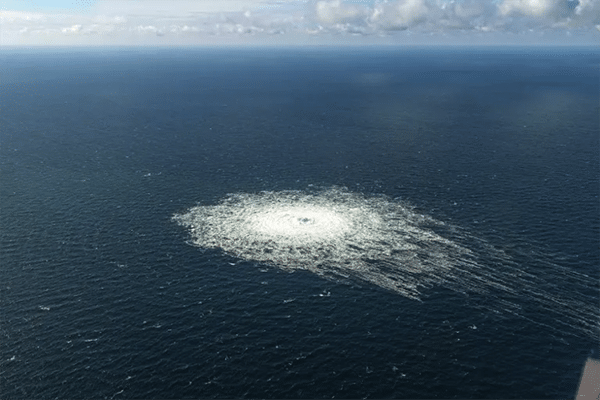Observers have drawn a number of conclusions based on a recent series of visits to the site of the Nord Stream pipeline rupture via drone. There’s just one problem: all of them seemed to have missed the location of the explosions.
After a recent underwater expedition, The Grayzone can now reveal where they went wrong, and what the real blast sites tell us about the worst act of eco-terrorism in history.
On September 26, 2022 and 3 minutes past midnight UTC, a magnitude 1.8 seismic wave struck the Baltic Sea. Finnish and Norwegian researchers placed the epicenter just southeast of the Danish island of Bornholm. 17 hours later, another 2.3 magnitude event occurred. The Swiss-based operator of the Nord Stream pipelines, which once fed huge quantities of Russian natural gas to Germany, reported a sudden drop in pressure from 105 to 7 bar in one of Nord Stream 2’s two offshore lines.
Overhead, aircraft filmed as an estimated 75,000—230,000 tons of methane bubbled up from the Baltic. Earthquake researchers said the force of the man-made blast was equivalent to 700 kg of TNT.
But what if the seismic readings they observed were not a result of the explosion itself, but rather, the subsequent force of the pipeline rapidly depressurizing?
Nine months later, several European countries have conducted investigations of the attack. But none have released their findings, and the question of who ordered the destruction of the Nord Stream pipelines remains the subject of intense public debate.
In an effort to shed light on the episode, the Grayzone has obtained never-before-seen footage from the scene of the crime.
The Grayzone acquired the underwater images and footage from Erik Andersson, a Swedish engineer who led an expedition to the Nordstream blast sites. This visual evidence refutes the widely-held theory that “hundreds of kilograms” of explosive materials were used to destroy the Nord Stream pipelines last September.
Experts consulted by the Grayzone say the footage indicates that the bulk of the damage suffered by the pipelines was not a result of the explosions themselves, but from the rapid release of extremely high pressure. For the first time, The Grayzone is releasing these images, which enable observers to ascertain the positioning, size, and type of charge used in the blast.
A highly pressurized blast
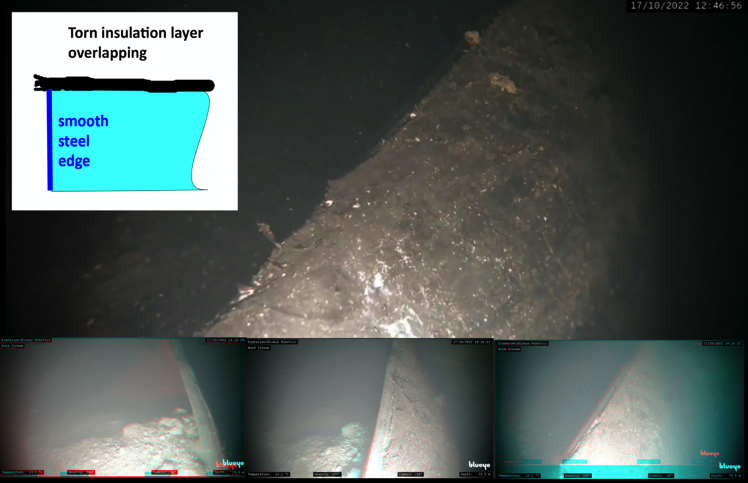
Graphic on left and anaglyph-3D by Michael Kobs. All images by Blueye. Attention: the small images in the lower row are anaglyph 3D images created from camera movement and have to be viewed with red/blue glasses.
Efforts to identify the perpetrators of the Nord Stream attack have been hampered by a lack of first-hand evidence. Well over a month went by after the explosion before the first journalistic expedition was made to the site. In November 2022, an underwater rover operated by a Norwegian company called Blueye obtained the first publicly-available images of the site, from which a number of conclusions have been drawn. While the footage clearly showed the wrecked pipeline, new recordings acquired by Grayzone suggest the Blueye crew failed to document the scene of the blast itself.
Subsequent trips to the scene by underwater drones have replicated this failure, leading Western media outlets to draw a number of rapid conclusions that do not seem to hold up to scrutiny.
This June, Denmark’s TV2 became the latest to weigh in, citing a French military expert in underwater ordnance who reportedly told the French outlet, Libération, that the deformities on the pipeline “look like something from a directional blast.”
As early as March, after the first underwater images from BlueEye, Chuck Pfarrer, a U.S. Navy SEAL and squadron leader of SEAL Team Six, advanced the theory that the perpetrators used shaped charges made in advance by a state actor and attached to the pipelines from a submarine.
But Michael Kobs, an open source investigator with an engineering background, disagreed with Pfarrer’s conclusions. Kobs argued on Twitter that because insulation material was preserved along the straight edges, no cutting charge (molten metal at high speed) could have penetrated the underlying steel where the insulation overlapped the edge of the steel, and no trace of heat exposure was visible. Kobs maintains that the fractures visible in the BlueEye video were instead the result of mechanical tension and the rapid decompression of the immensely pressurized pipes.
Erik Andersson, who led the expedition to all four blast sites this May, agrees with Kobs’ conclusions. Both experts concluded that none of the BlueEye Robotics videos showed the actual damage from the blasts. Instead, they became convinced that the actual bombings took place roughly in the middle of the approximately 250 meter sections of completely destroyed pipeline. As a direct result, the extreme overpressure tore the pipeline apart segment by segment, with the massive force sending the multi-ton pipe segments tumbling dozens of meters through the water.
The Grayzone’s new footage also appears to contradict both previous Western media claims that “hundreds of kilograms” of explosives were used, as well as the more recent proposal that the scheme could have been carried out using only a few kilograms of shaped charges.
As Kobs explains, “the seismic event appeared to be caused entirely by the sudden expansion of the gas,” rather than the detonation of the charges,
as the actual explosions likely left no trace in the seismic data.
So what conclusions can be drawn from the new data?
Understanding the placement and size of the explosive charges
Andersson and Kobs say they have come to believe that the attack’s perpetrators meant to place a bomb on each of the four pipeline strands.
This theory raises a question, though: why was the A string of the Nord Stream 2 pipeline blown up twice, 72 kilometers and 17 hours apart, while the B string of the same pipeline was left unharmed?
One possible explanation is the presence of massive power cables lying on the seabed near the site of the blast, which distort the Earth’s magnetic field so heavily that a compass can give false readings of up to 180°, a phenomenon Andersson observed at the scene.
Regardless, the 17-hour staggered explosions on the same A-string of Nord Stream 2 ensured that the pipe was under little or no pressure during the second explosion. This means the site effectively functions as a scientific control, as it is the only location at which an observer can see the damage caused by explosives alone—as opposed to the other breaks, where the pipe was seemingly deformed by the massive change in pressure.
Investigators called this spot on the depressurized pipeline “NS2SA,” meaning ‘Nord Stream 2—Swedish economic zone—String-A.’
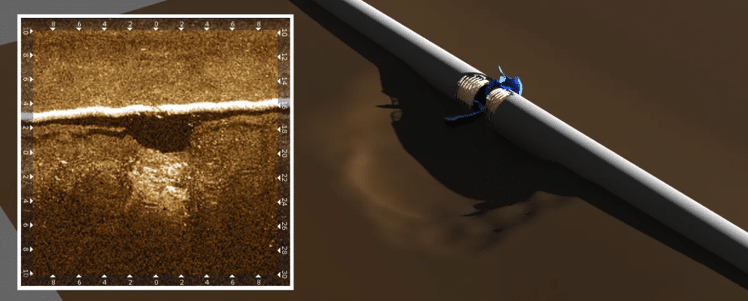
Fig. 2. Sonar image of Nord Stream 2 Line A in the exclusive economic zone of Sweden captured from the Baltic Explorer. Image on the right by Michael Kobs.
Video recording with the underwater drone proved difficult. The nearby magnetic field created serious interference with the compass, causing orientation difficulties. And the fact that the pipeline was submerged in light mud up to more than half its height meant that every movement of the drone raises a cloud of silt that made visibility difficult and at times impossible.
Kobs mapped the camera images and used the movement of the camera to generate anaglyph 3D images from two slightly different perspectives. This unusual method requires the red/blue glasses familiar to children’s magazines to view the images with a 3D effect. Researchers can turn images which are mapped this way into 3D models so that explosives experts can recreate them more easily.
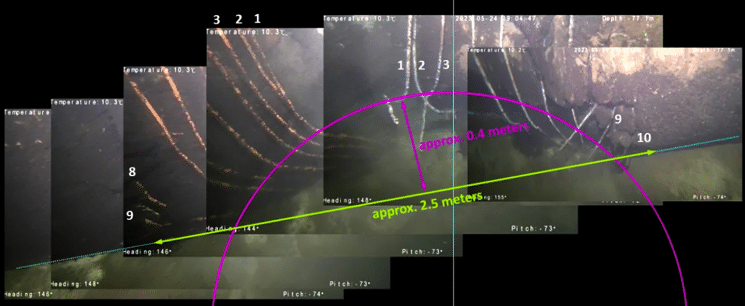
The destruction shows some revealing peculiarities. According to Kobs, the rough portrait painted by the model makes it appear as though “a giant wrecking ball has hit the side of the pipeline.” The concrete is destroyed over a distance of 2.5 meters symmetrically to the connection of two pipe segments, which is known as a “field joint,” he explains.
Visual analysis shows that the steel pipe has been pushed 30-40 cm inward and broken open. Of particular interest, he says, is the fact that the reinforcing steel has been sheared off at the level of the seabed.
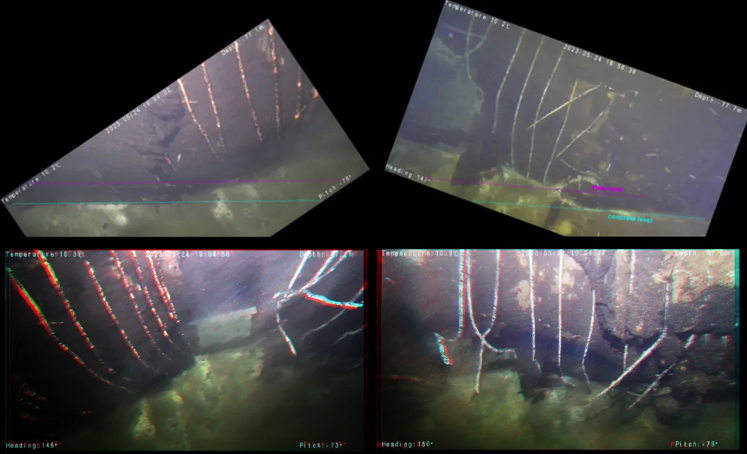
“This seabed is now in a crater caused by explosion and later by water and mud being sucked into the pipe,” Kobs notes. “One can conclude from this damage that close under the mud the concrete is still preserved or was destroyed in a delayed way and thus the reinforcing steel was sheared over the edge thus created and pressed against the pipe,” a phenomenon which he says could have three major causes.
First, the explosive charges seem to have been buried in the mud at the level of the crater floor, a proposition echoed by several specialists. Second, the pipeline appears to rest on a firmer layer of soil, which may have partly protected the underside from destruction. And the third component at play was most likely the shape of the charge.

A final notable feature of the damage is the rectangular outer layer of metal that originally wrapped around a joint between the pipe segments, which was punched out by the pressure of the shock wave. This section, specifically, gives us our closest look yet at how the blasts were carried out, as the outer limits of the uncoiled metal layer indicate the precise angle at which the shock wave hit the plate.

Kobs and Andersson see these data points as signs that a bulk charge was sunk into the ground next to the pipeline at the connection between two pipe segments, which would be the structure’s weakest point. If fully submerged, the explosive charge would be practically invisible to observers.
Erik Andersson estimated an amount of 60kg of TNT would be needed for such destruction. After numerous discussions with explosives experts, this figure had to be corrected downward only slightly, so that we have to assume a quantity of 50kg TNT or 40kg HMX. Furthermore, it must be reasonably assumed that the same method was used for all explosions.
“If we disregard the chain reaction caused by the overpressure at all the other crime scenes, the scale of destruction certainly seems calculated but by no means exaggerated,” Kobs says.
So these were no amateurs at work.
Still unknown, however, is what firing mechanism was used. While a timed fuse could theoretically have been used, there are a handful of reasons the perpetrators would be unlikely to employ such a device—most notably, once a timer is set, the only way to stop it is to return to the scene of the crime.
Given that the charges were placed just 80 meters below the waves in one of the most highly-guarded bodies of water in the world, this possibility seems rather remote.
Official cover-ups and suspicious storylines
A joint letter from Sweden and Denmark to the UN Security Council on September 29, 2022, described “at least two detonations” and stated that the earthquake corresponded to “several hundred kilograms” of explosives. NATO promised a firm response to what it declared an intentional act of sabotage. Russia demanded investigations, but instead of an international commission of inquiry with Russian participation, Germany, Denmark and Sweden began their own investigations, but prevented the pipeline’s operator, Gazprom, from surveying the damage.
Though Sweden collected evidence from the seabed, it has so far refused to share the results of the investigation with other states, citing “national security.” The German government blocked a request for clarification on the blasts by a legislator, claiming it is in the “public interest” not to divulge information which originated with a foreign intelligence service.
This March, U.S. President Biden and German Chancellor Scholz met behind closed doors. In the following three days, the New York Times and several German outlets published reports claiming the perpetrators were most likely a “pro-Ukrainian group” using a chartered sailboat, citing anonymous U.S. intelligence sources.
After months of accusations by Western states that Russia carried out the attack against itself, the narrative about Russian “ghost ships” began to crumble. On May 21, the Swedish paper, Expressen, wrote that “the Russian ships have been able to be excluded from the investigation” because “their positions have been mapped and the conclusion must be that they have not been in such a place that they could have carried out the deed.”
Several days later, the Washington Post reported that none of evidence available pointed to Russia’s involvement.
By this point, German investigators had floated a new narrative through selected outlets to explain the attacks. According to the storyline, a six-member team of pro-Ukrainian nationalists chartered a sailing yacht called “Andromeda” to blow up the Nordstream pipelines on former Ukrainian President Petro Poroshenko’s birthday.

The Andromeda boat supposedly used to sabotage the Nord Stream pipelines
Somehow, the small team was able to fit heavy oxygen tanks, adequate gear, and explosives onto the 15 meter-long sailboat and conduct the operation without the help of a decompression chamber. And they were able to carry at least 40 to 50 kg, or about 100 pounds, of explosives to the pipelines by themselves.
German investigators claimed to have tracked down the Andromeda months after the attacks and found not only traces of HMX explosives, but also forged passports. Who tipped the investigators off about the yacht remains unclear.
The story of the six pro-Ukrainian divers took a surprising turn with the release of the so-called Discord Files, those top-secret documents distributed by jailed Air Force intelligence leaker Jack Teixera to a select group of friends on a Discord chat group. Following Teixera’s arrest, the Washington Post was granted exclusive access to the files.
In a June 7 article, the Washington Post cited intelligence gleaned from the Discord Files to assert that the Ukrainian military had secretly orchestrated the Nord Stream sabotage. “All those involved reported directly to Gen. Valery Zaluzhny, Ukraine’s highest-ranking military officer,” the Post claimed,
who was put in charge so that the nation’s president, Volodymyr Zelensky, wouldn’t know about the operation, the intelligence report said.
The paper’s reference to Zaluzhny being “put in charge” of the operation raises the obvious question of who, or what, placed Ukraine’s commander-in-chief in control of such a dangerous mission without Zelensky’s knowledge. Could it have been a three letter agency of one of Ukraine’s patrons, like the U.S. or UK? Subsequent Western media coverage has largely declined to address the issue.
According to the latest narrative advanced by anonymous American intelligence officials in outlets like the Washington Post and the New York Times, the U.S. directly warned Ukraine not to attack Nord Stream in the months before the attack. German officials say they believe Ukraine went ahead with the mission anyway after changing a handful of details of their plan—changes which supposedly explain why the CIA’s supposed warning failed to stop the attack.
But following the alleged publication of leaker Jack Teixera, nothing has surfaced to support the hypothesis that the CIA intervened to prevent the plot from being carried out. And with Teixera held incommunicado, no one with direct knowledge of the documents is available to contradict publications like the Washington Post.
There are other holes in the Andromeda narrative which mainstream commentators have so far declined to address.
The case of the disappearing diver
Perhaps the most notable of the issues surrounding the Andromeda storyline is the complete disappearance of one of the supposed divers from the internet between 2017 and 2022. According to Sweden’s Expressen,
since 2017, we have not been able to trace any posts or pictures of the man, nor among his relatives.
Despite the complete absence of a digit footprint, the suspect’s picture was used by an account set up just one month after the Nord Stream explosions. This account belongs to a simple Russian-language Stay-Friends-like website that was launched as recently as August 2022.
The Grayzone found that nearly all accounts created on this website were never visited again after their initial creation. This means the digital user IDs, which are automatically assigned when an account is created, follow the same chronology as the “last visited” timestamps in 95% of all the accounts.
The question therefore lingers: did the alleged Nord Stream diver want to make new friends on a Russian-language social media site, or was someone using a missing person’s identity to create a false trail of digital breadcrumbs?

